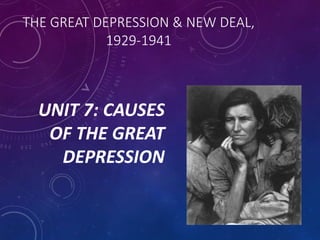
Causes of the Great Depression
- 1. THE GREAT DEPRESSION & NEW DEAL, 1929-1941 UNIT 7: CAUSES OF THE GREAT DEPRESSION
- 2. ORIGINS AND CAUSES • Extreme wealth inequalities • Big difference between rich and poor • Ballooning stock market • Over speculation and buying stock on margin would lead to the Stock Market Crash (Black TUESDAY 10/29/1929) • Over reliance on unprotected loans • We still had countries paying debt from WWI • Too much speculation & borrowing
- 3. STOCK MARKET CRASH • 1920's had been a period of good economic times • However on Tuesday Oct. 29th, 1929 - NYC Stock market crashed, causing a depression that would last until 1940
- 4. HOW THE STOCK MARKET WORKED • the public invests in companies by purchasing stocks; in return for this they expect a profit • b/c of booming 1920's economy, profit was plentiful, so banks were quick to make loans to investors • Stock Market Rap
- 5. STOCK MARKET • also investors only had to pay for 10% of the stock's actual value at time of purchase • this was known as BUYING ON MARGIN, and the balance was paid at a later date
- 6. STOCK MARKET • this encouraged STOCK SPECULATION - people would buy and sell stocks quickly to make a quick buck • because of all this buying & selling, stock value increased • The prolonged Bull Market of the 1920's saw stock prices rocket from an average of $50 per share in 1922 climbing to a massive $350 per share in 1929. Stock prices began to rise sharply in 1926 - 1927. The high point for the 1929 market was August 1929 at $350. • this quick turnover didn't aid companies • they needed long term investments so they could pay bills (stock value was like an illusion)
- 7. INEQUALITY CAUSES A RIPPLE EFFECT • a major problem: uneven distribution of wealth • 42% of the population was below poverty line • Top 1% owned most of the wealth • of the 58% above the poverty line, most fell into the middle class category • they were not wealthy; they had jobs b/c of the industrialization & consumerization of the American marketplace
- 8. INEQUALITY CAUSES A RIPPLE EFFECT • this middle class depended on their salaries and when productivity declined they lost their jobs • and because of low savings, they had to cut back on their purchases • this decline in spending among the middle class ruined the whole country
- 9. PRESIDENT HOOVER • Opposed direct federal aid • Instead he believed in: • Self-help & volunteerism • Self-help cooperatives • This means the government did not think it was their job to help the people financially
- 10. PRESIDENT HOOVER’S RESPONSE • He didn't believe that the gov't should play an active role in the economy • He persuaded bankers/business to follow his policy of VOLUNTARY NON - COERCIVE COOPERATION where he gave tax breaks in return for private sector economic investment • Hoover also organized some private relief agencies for the unemployed • Believed it was the Church's job to aid those in need not the Government
- 11. HOOVER’S RESPONSE: RECONSTRUCTION FINANCE CORPORATION • Established in 1932 by Hoover • Gave emergency loans to banks and businesses because Hoover believed cheap loans would spur business • It granted over 2 billion dollars to the local and state governments • Hoover believed the money invested would “trickle down” to average Americans • Too little, too late
- 12. PRESIDENT HOOVER’S RESPONSE • He worked out a system with European powers that owed U.S. money as a result of WWI debts = HOOVER MORATORIUM • put a temporary stop to war debt & reparations payments • European countries were to purchase American goods instead to stimulate American economy
- 13. GOOD IDEA IN THEORY… • In early 1931 these measures appeared successful, but then......the TARIFF WARS began • Democrats in Congress passed a high tariff (SMOOT- HAWLEY) to protect U.S. industry (hoped to stimulate purchasing of U.S. goods) • this turned out to be a fatal error... • Congress did not understand that the world had become a GLOBAL ECONOMY • In retaliation other countries passed high tariffs and no foreign markets purchased American goods, so U.S. productivity decreased again
- 15. FEDERAL RESERVE POLICY • In the 1930s, the United States was on the gold standard. • This means the U.S. government would exchange paper dollars for gold at a fixed price • Commercial banks and the Federal Reserve held a portion of their reserve as gold coin and bullion. • A decrease in gold reserves would lower the amount of money in circulation • Therefore, large withdrawals of gold from banks could reduce bank reserves so much that banks would be forced to call in their outstanding loans.
- 16. FEDERAL RESERVE POLICY • During the 1920s the Federal Reserve cut interest rates to stimulate economic growth • In 1929 the Federal Reserve worried investors were speculating too much with borrowed money so they decided to limit the money to supply to discourage lending THEY DID THIS BY RAISING INTEREST RATES • As a result there was too little money in circulation to help the economy after the stock market crash
- 17. BANK FAILURES • The failure of the Bank of the United States, the failure of other banks and the suspension of operations by nearly 7,000 banks created a bank panic. • If depositors lose confidence in their banks, people will rush to withdraw their money from the bank to avoid losing their funds. • When depositors remove money from the system, banks may be forced to reduce their outstanding loans; requiring full payment or foreclosure.
- 18. HOOVERVILLES
- 19. SEATTLE, 1931
